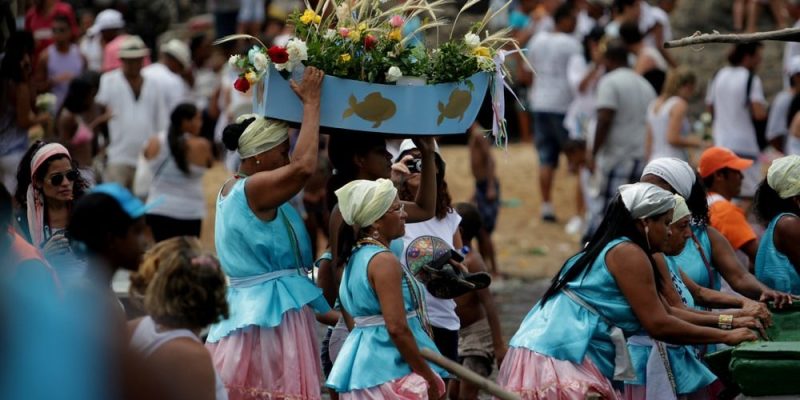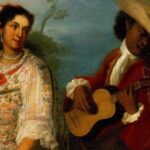We explain what candomblé is, how its origin was and what its beliefs are. In addition, we will tell you how it differs from umbanda.

What is candomblé?
The candomblé It is a religion of African American origin, spread in different countries in South America: mainly in Brazil, but also in Argentina, Paraguay, Venezuela and Uruguay. Its practice is a direct inheritance from colonial America and the hybridization that took place between the different African cultures that arrived on the continent in conditions of slavery, including the Yoruba, Bantu, Dahomé and Mahin.
It is an animist religion, in which the animals are worshiped. orixás that is, to the spirits or guardian deities of the different fields of natural life and the different emotions and human needs. Widely spread in Brazil, it is practiced by approximately 3 million citizens (1.5% of the total population of this country) and Its main seat of worship is located in the city of Salvador de Bahía.
Candomblé should not be confused with other American religions of African origin, such as Umbanda, Batuque or Caribbean Santería, although they share strong cultural and ethnic ties. Candomblé is currently part of the Brazilian cultural heritage and folklore, despite the fact that its cult was historically persecuted and even criminalized by some social and religious sectors.
Origin of candomblé
Like other religions and cults of African origin, The principles of candomblé came to America in the 16th century, in the traditions of African slaves taken to colonial plantations as labor.
In the case of Brazil, these slaves belonged to the Bantu, Yoruba, Ewe and Fon ethnic groups, mainly native to present-day Nigeria and Benin. Although they spoke different languages and practiced their religion in slightly different ways, once on American soil, cultural assimilation and hybridization occurred among them that sowed the seeds of various Afro-Brazilian cults, such as Candomblé.
The “formal” appearance of candomblé, however, took place at the beginning of the 19th century, when the first temple was founded in Salvador de Bahía (terreiroin Portuguese) dedicated to the cult: Ilê Axé Iyá Nasseither Okalso known as the “Terreiro de Casa Blanca”.
Its foundation is attributed to Iyá Nassô, a freed slave and first priestess (mãe-de-santo) of the cult, which had participated in the founding of other previous temples in the city. But it is said that in 1835 his family was accused of instigating an uprising among the slaves and they were forced to return to Africa. Then, one of his former companions, named Marcelina, assumed leadership of the temple until her death in 1885.
New terreiros They arose later, as a result of internal disputes and disagreements among the faithful, but always under the disapproving gaze of the Catholic Church and the upper classes of society, who feared a slave revolt like the one that occurred in Haiti at the beginning of the 19th century would be replicated in Brazil. 19th century. So, for example, In the first republican constitutions of Brazil (1891) cults of African origin were prohibited indirectly, since the use of talismans, magic, spiritualism and other important practices in Candomblé were punished.
However, the first decades of the 20th century allowed the public resurgence of candomblé along with other African religions, to the extent that Brazilian society accepted to define itself as the result of miscegenation and multiracial in nature. Around 1930, the first academic studies on Candomblé emerged, which allowed it greater standardization and greater public recognition, thanks to the contributions of academics such as Raimundo Nina Rodrigues, Edison Carneiro and Ruth Landes.
This context was also conducive to the emergence of the Bahian Federation of Afro-Brazilian Cults, among other institutions that recognized and defended the African religious legacy. This greatly contributed to Candomblé being respected and accepted. Even Mãe Menininha do Gantois, spiritual leader (iyalorixá) from the also famous terreiro Ilê Axé Iyá Omin Iyamassêwas often recognized as a symbol of Brazil and Brazilian folklore.
Candomblé beliefs

The candomblé It is a totemic and animistic religion, which believes in the existence of a nature spirit comparable to the anima human whose specific aspects are distributed among a group of deities called orixás, voduns either nkisisand who act as patrons of humanity. Candomblé practitioners, therefore, worship them and make offerings and gifts, depending on what the deity “asks for.”
Above the orixás There is, however, a deity more or less equivalent to the monotheistic god, that is, a supreme god responsible for all things, who is Olorun, Zambia either Mawu. The existence of minor divinities does not contradict the authority of this main god who maintains universal balance, and who also rules over the afterlife or the world of the deceased.
The difference in the names of the Candomblé deities is due to the syncretic and diverse nature of the cult, which has roots in different African languages. On the other hand, the religious calendar of this religion often coincides with the Catholic one, which is due to the fact that in colonial times the African cult was disguised through the Catholic celebrations themselves.
Differences between candomblé and umbanda

Candomblé and Umbanda are Afro-Brazilian religions, heirs of the culture that African slaves brought to America and intermingled there with indigenous cultures and with Portuguese Christianity. Both respond to cultural and religious patterns that were more or less common in Africa at the time that is, they were shared to a certain extent by different ethnic groups, although in different languages and with particularities. However, these are not equivalent religions.
In fact, Candomblé is a much older religion that more faithfully reflects African culture of colonial slaves. Their dances, offerings and rituals are, at the same time, much more diverse, since candomblé is not practiced in a single, standardized way. Even so, in their celebrations Candomblé does not usually have mediums and spiritual possessions, which is extremely common in Umbanda.
For its part, The Umbanda is a younger cult, born at the beginning of the 20th century, and with a greater degree of syncretism that is, hybridization between indigenous, African and Catholic culture. At the same time, it is a more institutionalized, standardized and theologically consolidated cult than Candomblé, which is more traditional.
References
- “Candomblé” on Wikipedia.
- “ABC of Candomblé” in La Nación (Argentina).
- “Candomblé, the religion that 'resists' the growing intolerance in Brazil” in Agencia EFE.
- “Candomblé (Brazilian cult)” in The Encyclopaedia Britannica.





